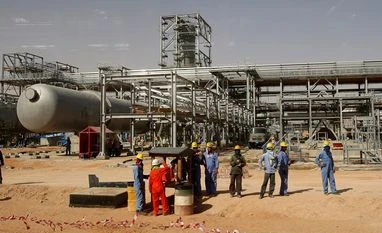The Organization of the Petroleum Exporting Countries’ (Opec’s) latest move to stabilise crude oil prices in partnership with Russia could be more successful than previous attempts.
The Organization of the Petroleum Exporting Countries’ (Opec’s) latest move to stabilise crude oil prices in partnership with Russia could be more successful than previous attempts.
The Organization of the Petroleum Exporting Countries’ (Opec’s) latest move to stabilise crude oil prices in partnership with Russia could be more successful than previous attempts.
With Russia, the oil cartel accounts for 53% of world crude production, based on 2015 data. On their own, the 13 members of Opec accounted for 41.4% of world production in 2015.
Historically, there is strong correlation between the movement of oil prices and Opec’s market share. The latter rose nearly from 40.8% in 2002 to 43.8% in 2008. Global crude prices in the same period nearly quadrupled, from $25 a barrel (annual average) to nearly $98/bbl. Similarly, a drop in prices in 2014 and 2015 coincided with a nearly 250 basis points (2.5 percentage points) decline in Opec share.
Earlier this month, Opec countries announced plans to cut their output by 1.2 million barrels a day (bpd) and Russia contributed with a cut offer of 300,000 bpd. This is equivalent to 3.1% and 2.7% of Opec’s and Russia’s average daily crude production in 2015, respectively, according to the BP Statistical Review of World Energy.
International crude oil prices are up 16% since November 30, when Opec first announced plans to cut output in conjunction with Russia. Headquartered in Vienna, Opec is an association of 13 leading oil exporters. It seeks to regulate members’ production members to ensure stable oil prices.
“Opec and Russia are attempting to counter the growing dominance of North American oil production. They are trying to bring the market to a sensitive equilibrium which they can control,” says Kishore Narne, associate director at Motilal Oswal, the financial services entity.
More From This Section
“Opec let prices trade below $45 for a long time and managed to hamper additional investments in (US) shale oil. For those (latter) investments to earn returns, crude has to sustain above $55-60 for a significant amount of time, maybe a year or so.”
A decline in Opec’s pricing power was triggered by a boom in shale output in the US and Canada, beside a production surge in Russia. US production grew by 85% between 2008 and 2015, against a 9.5% and 3.5% rise in the output of Russia and Opec countries, respectively. Canada contributed with a 28% increase. This pushed Saudi Arabia, top producer in Opec, to third spot in oil production in 2015, behind the US and Russia.
However, sagging crude prices hampered investment in US shale oil. Monthly crude production in the US declined to 8.74 million bpd in August from a record high of 9.63 mn bpd in February. The monthly average for 2015 was 9.42 million. Opec countries also have to be mindful of global economic growth. In 2008-2011, oil prices mirrored the dips and increases in growth of gross domestic product; from 2012, the story is markedly different. In the years since, global GDP growth seems to have stabilised, while oil prices have consistently fallen.
Gnanasekar Thiagarajan, director at Commtrendz Research, believes oil prices have a direct bearing on economic growth: “When oil prices get too expensive, it tends to have a negative effect on global economic growth. Opec and non-Opec countries are aware of this. In my opinion, they will ramp up production if prices cross $65 a barrel.”
Narne, however, disagrees. “It is a common myth that lower crude oil prices trigger growth. Crude production is also a part of GDP. Relatively higher prices of crude are an indication of higher growth, as prices are trading high due to increased demand. If crude goes to $120-130, beyond one’s imagination right now, this will cause inflationary pressures which will push down growth. But, reasonably high levels of crude generally have a net positive impact on global growth.”
For now, this unity of Opec and Russia in protecting prices might itself, as a perception, be enough to keep oil trading at high prices. Thiagarajan opines: “Supply and demand-wise, I don’t think the cut is going to make a big difference to the fundamentals. But, sentimentally, it will on prices. They’ve clearly displayed to the world their resolve to fight any scare of falling prices.”
)